August 4, 2022 (Updated January 25th, 2023)
Case study: How Ayoa Can Nurture The Future Of Education
Do you think that mind maps are only for the creatives? What do you think then would happen if mind mapping was to be introduced into a sustainable construction diploma course? Tim Fenn is a lecturer in construction management, specialising in sustainable construction and innovation, and for over 2 years he did just that with Ayoa. Read on to find out how Ayoa can stimulate the future of education.
Tim started using mind maps about 30-40 years ago as he tried to find a different, more effective way of studying for himself. “I used to carry big boards to record what was said in the lectures,” he says. Now that he is on the other side of the lecture hall, and is delivering a learning experience to others at the University of Hertfordshire and Moulton College, having discovered first-hand the benefits mind mapping can bring to education, Tim has been inspired to add mind mapping to a curriculum of his own.
Gone are the days of mind mapping on big boards though. As a modern-day lecturer, finding a digital way of mind mapping, especially during the pandemic, has been crucial for Tim. With Ayoa, Tim is able to continue with his teaching pattern even in the world of online learning. This makes it completely different to the conventional way of teaching through PowerPoint presentations.
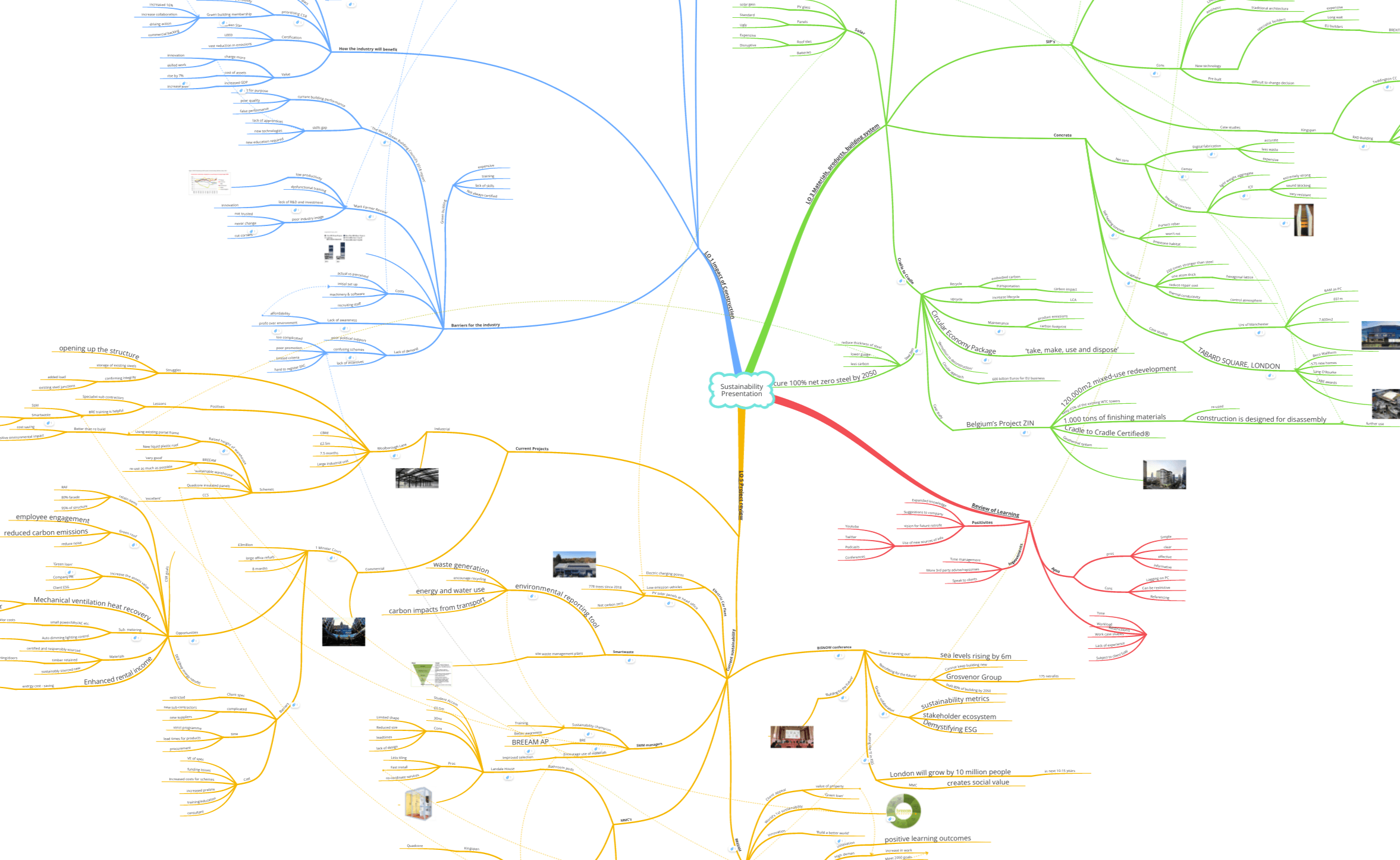
Having used mind maps in creating business plans, planning events and projects, Tim is well aware of the invaluable versatility and ability to induce deep learning which they can offer his students. Being part of the workforce already though, Tim’s students are already experts in their own right. His cohort of learners consist of 22-45 year olds ranging from housebuilders working in small organisations, to assistant construction managers and civil engineers managing high profile jobs and multi million pound investments such as the HS2 project.
So how did they find the development of their skills with mind mapping being the driving force behind their education?
Ayoa mind mapping and students
Mature students, although having extensive practical experience, sometimes lack academic certificates or qualifications to reflect their expertise. This can wrongly leave them lacking a competitive edge within a highly competitive job market. It does however mean that this population strives to expand their educational credentials. When trying to find a learning method which best suits such learners, Tim has always speculated that, “mind maps [would] work very well with construction students because they’re used to working with plans and schedules. And a mind map is really just an extension of thinking, mapping the thinking.”
How Tim’s theory panned out in reality, very closely matches his hypothesis. Despite a bumpy start (as there always is with anything new), Ayoa and its mind maps delivered a hugely beneficial impact on his students’ engagement even through the disruptions of the pandemic.
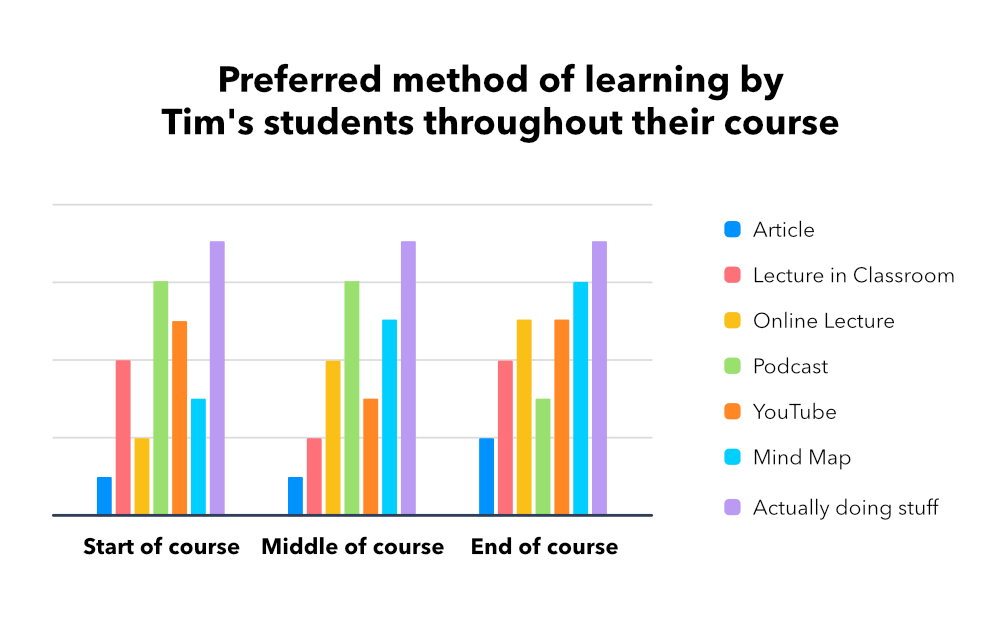
As you can see, from the above bar charts, the popularity of the various learning methods Tim applied during his course varied over time. Unsurprisingly, given the practical nature of his course, ‘actually doing stuff’ remained the most favoured throughout. However, the story of mind mapping is quite different – going from the bottom 3 in the popularity standings to being a close second to practical work!
It goes to show that initial unfamiliarity doesn’t automatically mean that something is destined to not succeed. In fact, mind mapping’s gradual rise in popularity is in contrast to other delivery styles which are typically lauded by students – those of podcasts and YouTube videos.
Whilst the appetite for podcasts waned over time, and YouTube videos experienced a turbulent time (just managing at the end of the course to claw back to their initial popularity rating), in comparison, learning via mind maps went from strength to strength. The affinity which students felt for mind mapping by the end of the course was so great that their popularity had increased by 100%!
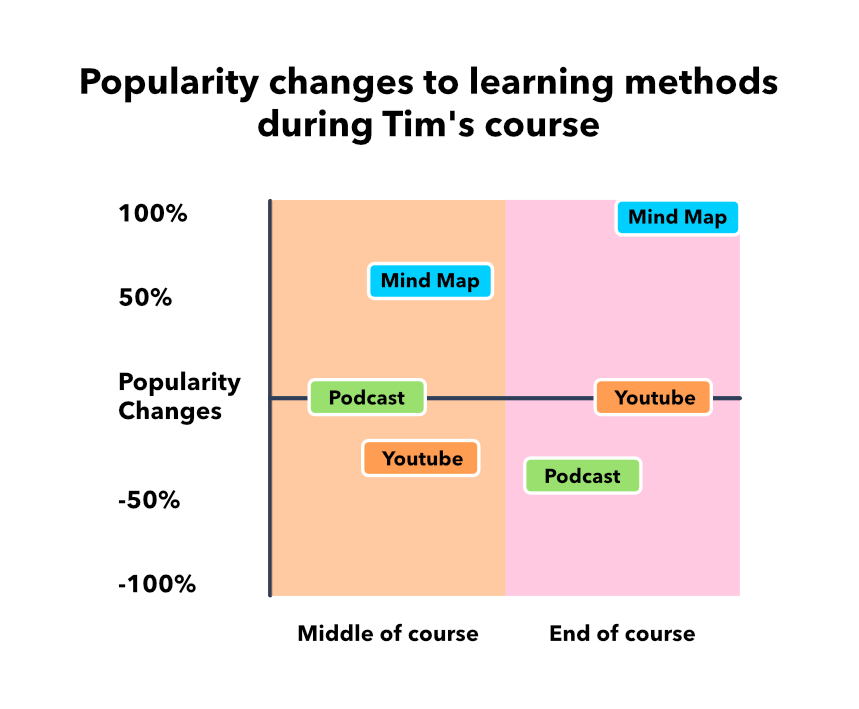
Clearly, despite the contemporary trend of podcasts for the last few years, and the idea that YouTube videos making learning as easy as watching TV, mind mapping was able to deliver something which these learning methodologies couldn’t. No doubt the rise of mind maps had something to do with the fact that along with driving engagement, they also work with people’s brains to produce better learning outcomes. After all, nobody is going to turn their nose up at a fun, easy way of learning which breeds results.
However, being an innovator and literal builder of a new world, Tim wasn’t content with merely applying mind maps in their typical educational capacity of breaking down content or for revising. He also used them with his students to conduct a time constrained, mind mapping exam for one of his modules. An experimental approach to say the least but it paid dividends for both his students and himself alike. A poll suggested that most of Tim’s students found this assessment method interesting, they enjoyed the exercise and thought it was very relevant to their work. The students’ perception of the success of such an exam (not how you typically hear students associating with exams) can be summed up by the fact that they felt it was actually the best format for an exam!
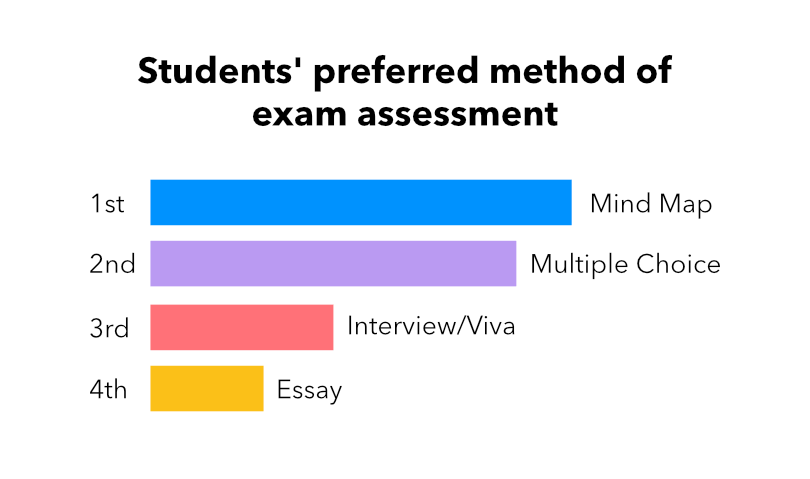
Tim said, “They all thought that the mind map exam was a great way to assess knowledge and I would agree. I think it’s a great way to demonstrate thinking, to be able to assess whether people are thinking or not.”
Future of education – a question for educators being answered by students
Thinking is not only something which students are expected to do, educational providers likewise need to keep their grey matter ticking over. This has never been clearer following the vast change in the way daily activities are carried out following the pandemic. Right from the way we socialise to the way we work and learn, everything has turned upside down. It’s safe to say that the future of education will be nothing similar to how education was even half a decade ago.
As an educator seeking to inspire future generations, Tim thinks about this a lot. Particularly at university level he sees “more students questioning the fees, and questioning how lectures are delivered. I think it’s obviously moving towards a blended, maybe mixture of in class and online learning, where students will have greater participation in the design of the learning, designing of how the courses are delivered, the content, and the learning outcomes.”
Such a change requires a reassessment of conventional learning methods, especially if they are to be delivered online. And this, is where software like Ayoa comes into play for Tim:
“Ayoa is the perfect way to get better engagement, encourage thinking and make education a learning experience more than just an in class lecture.”

However, Tim is mindful that the future of educational courses is not just to be determined by how they are delivered. In the future, more courses – particularly at tertiary level – will have a greater emphasis on student requirements. One of these is achieving deep learning, to satisfy the demand of potential employers. Companies now want people that can problem solve, be creative and are able to communicate these changes or impacts. For any student, not just those seeking to upskill via Tim’s Construction Management Degree, this is a must when investing in further education.
Whilst there are plenty of online platforms now available to deliver educational resources, none, if any, take into consideration these modern employment demands like Ayoa does in Tim’s opinion. Thanks to it’s grounding in mind mapping:
“Ayoa promotes creativity, deep learning, independent thinking, and actually starts getting learners to learn to learn, and have fun with learning.”
Neurodiversity and education
Making learning fun has been a challenge for educators since the dawn of time. Whether it’s uninspiring topics or the dread of exam pressure, learning isn’t always at the top of the fun activities list. Changing this doesn’t have to be radical though, it can simply be a matter of doing the right thing.
Inclusivity in education is more important now than ever. This is not limited to race, gender or sexuality, it also vitally encompasses neurodiversity (the difference in how our brains think, remember and learn). Neurodiversity is of utmost importance to Ayoa which offers different modes of learning to everyone. With 1 in 7 people being neurodivergent, and Tim having dyslexic students on his course, this aspect of Ayoa is yet another reason why this revolutionary educational tool is appreciated by him and his students.
How Tim puts Ayoa’s neuro-inclusive design to good use is rather simple – he creates the same learning materials on an Ayoa whiteboard in a linear fashion and then replicates them into a more visual, organic, mind map at a click of a button. This gives his students a choice to learn in a manner they are comfortable with. Tim explains, “some people don’t respond as well to visual mapping, they prefer lists and I can do the lists in the whiteboard section of Ayoa – the software allows each individual to accept and adopt the learning style they prefer.”
Conclusion
“You’ve got to question whether people are actually learning and what deep learning is coming out of your practice,” Tim believes. These questions are also being asked by more and more fellow educational professionals as they try to make sure that their curriculum prepares learners for the work they are seeking to graduate into.
For Tim, “as a three dimensional platform or framework for integrating learning, creative thinking and task management,” Ayoa is the educational solution that he is confident rolling out to his learners. This confidence grows on the basis of results – both those seen by the teacher in the classroom, and real-life examples outside of studying. For instance, when comparing Ayoa educated students to traditionally educated students, Tim says he finds them more creative, better at problem solving and are more in demand in workplaces. Since the introduction of Ayoa, Tim has already seen two of his students excel and have a progressive career change. This was a direct result of attending modules driven by Ayoa.
In many parts of life, it’s said that participating is what counts. However, with education often being an investment in time, and in some cases money, results like the ones Tim is already seeing in his Ayoa-led learners count for a lot. Some courses encourage speculative thinking which leads to answers which are up for interpretation. Whilst others focus on educating via data and hard facts. As it is still in its infancy, maybe Tim’s mind mapping teaching method remains up for debate, but one thing is for sure – the increasing amount of positive results it is churning out suggests that educators everywhere can learn a lot from it.
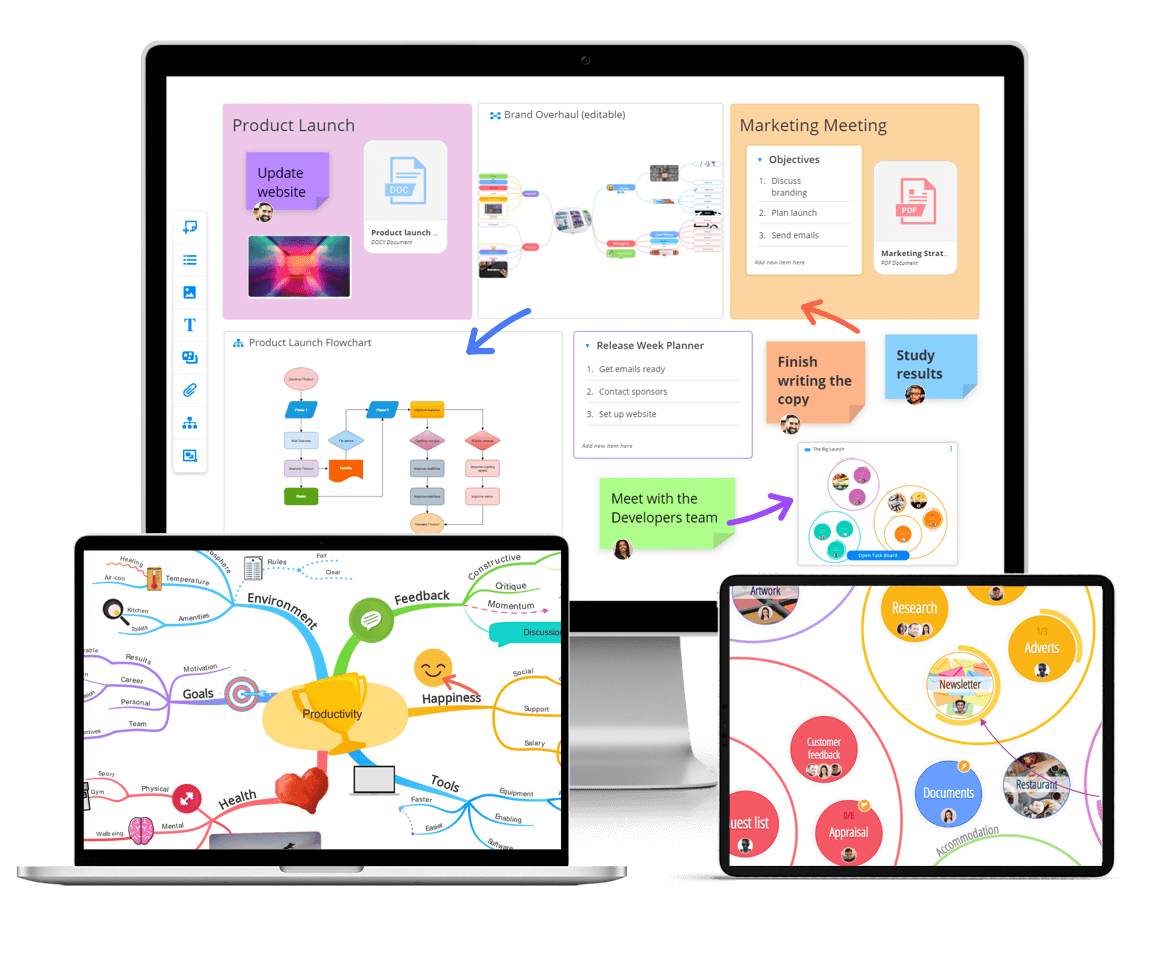
Inspire Creative Learning
Ayoa is an all-in-one platform where minds expand, learning becomes collaborative, and teaching is fun. Turn heads as you make education about looking forwards rather than backwards.
Try it for free